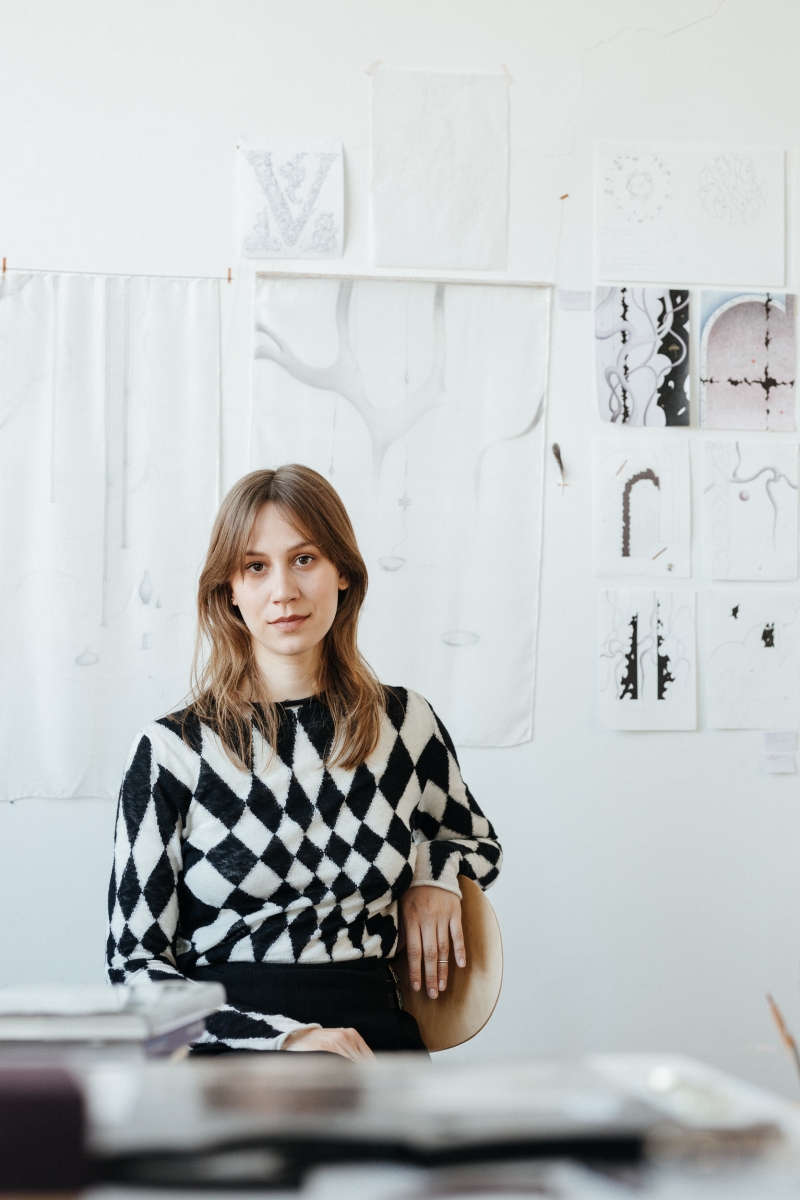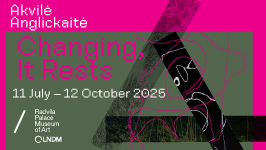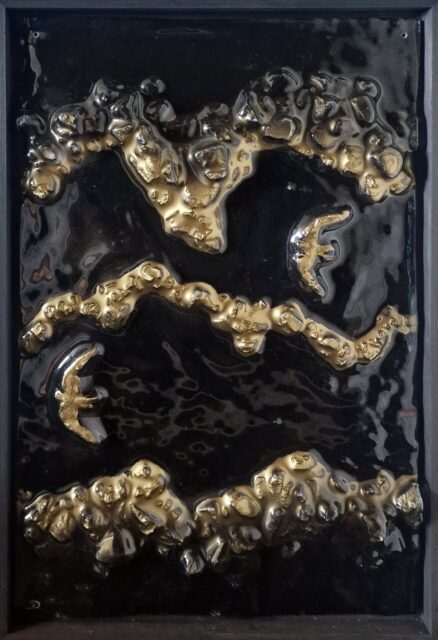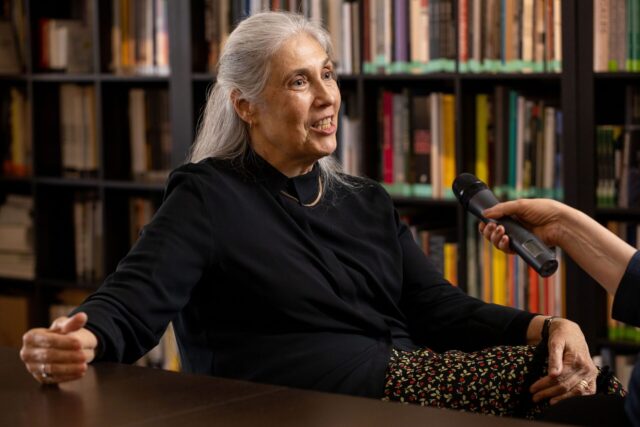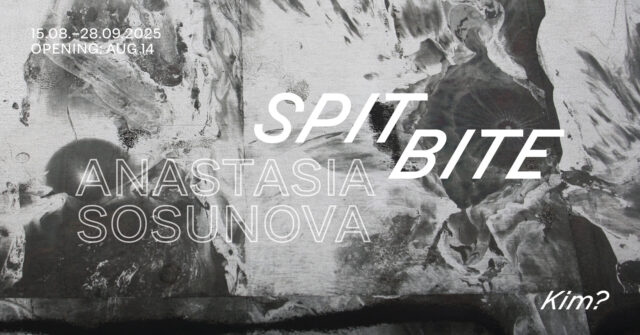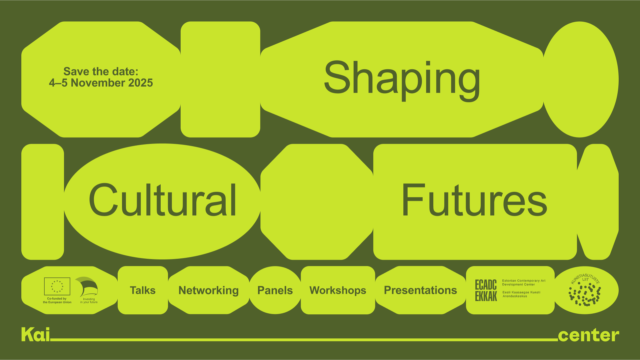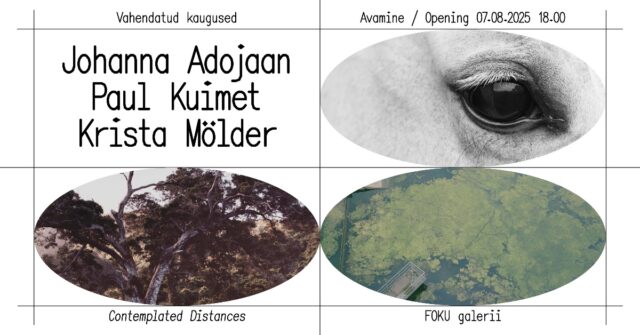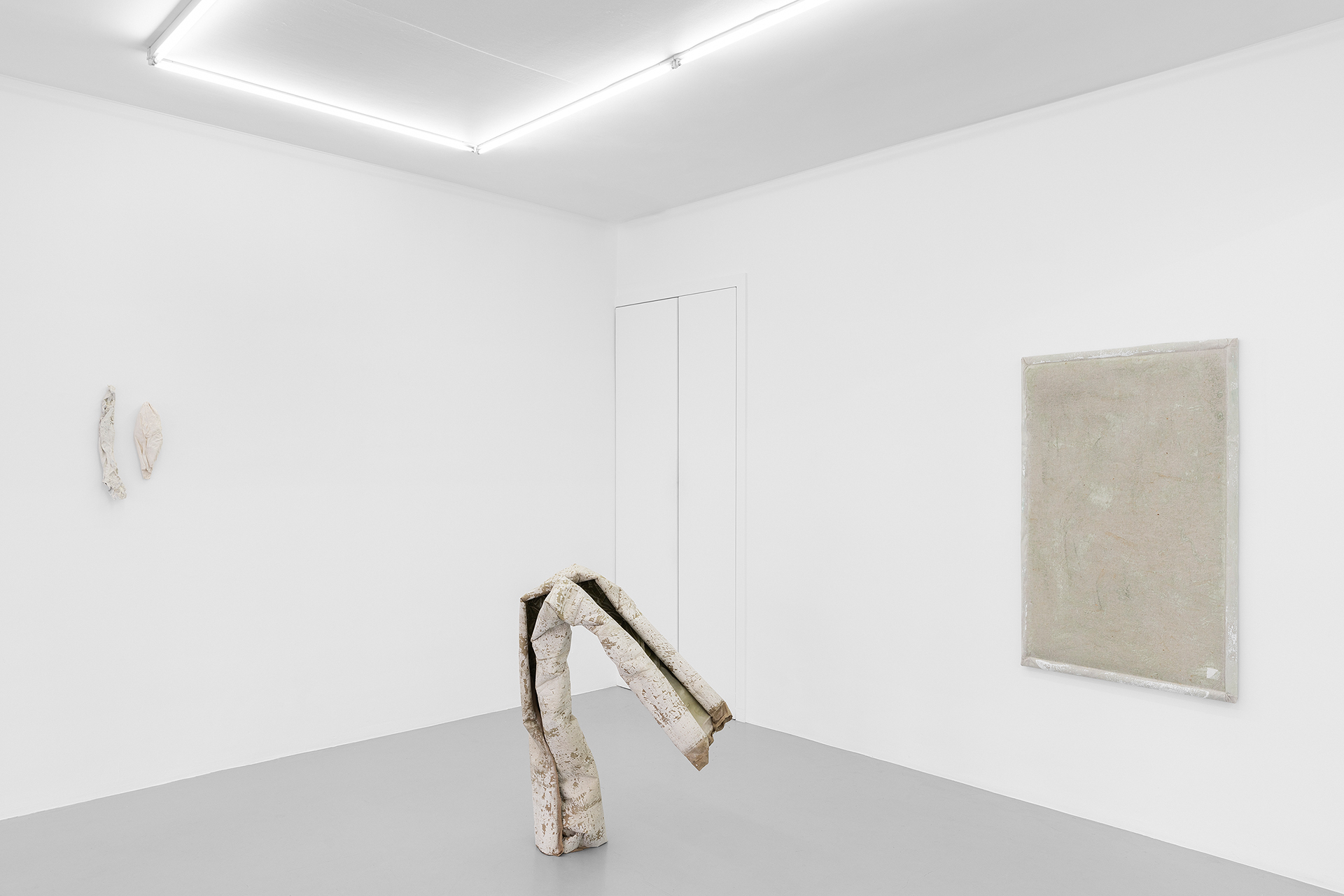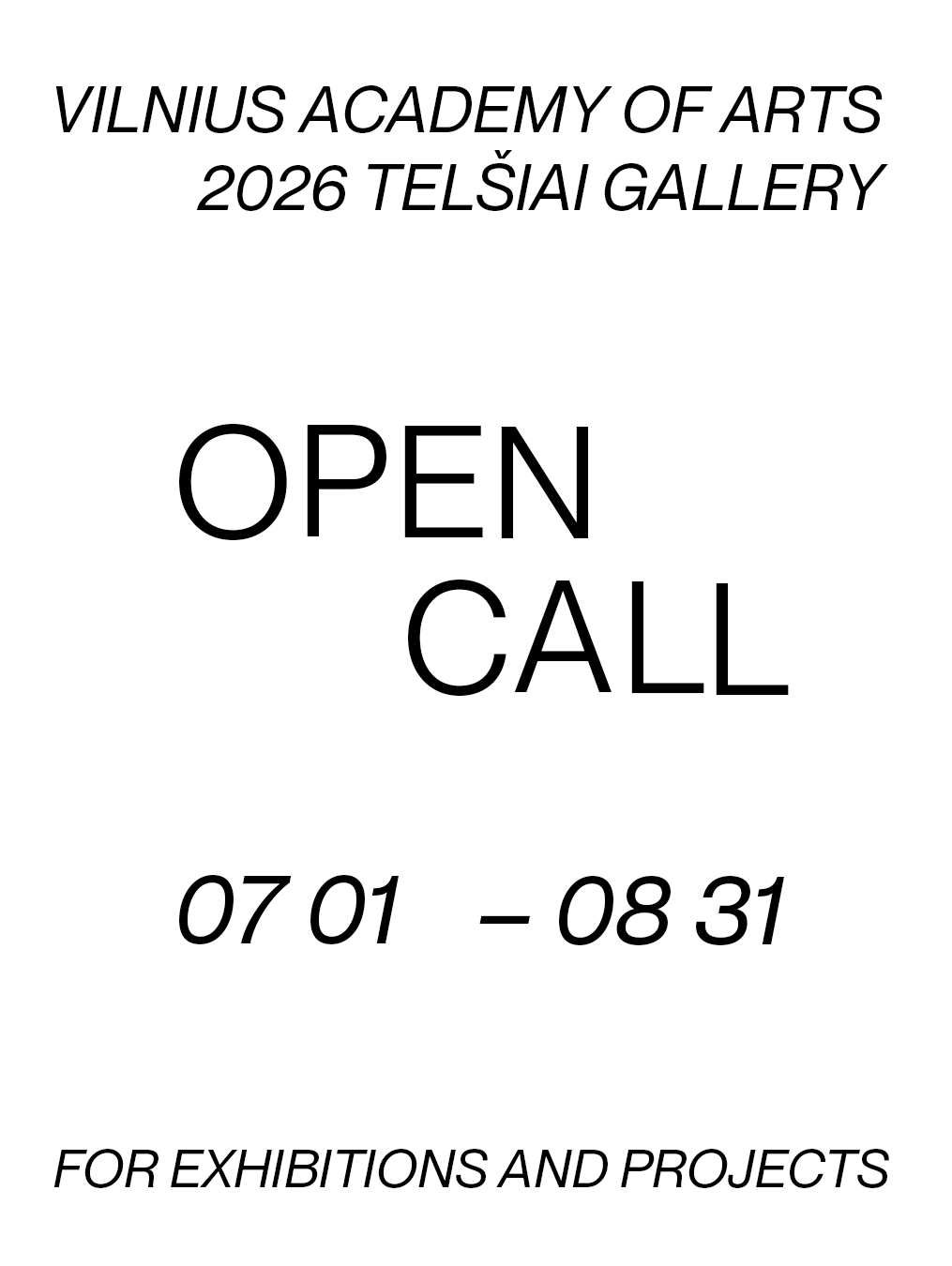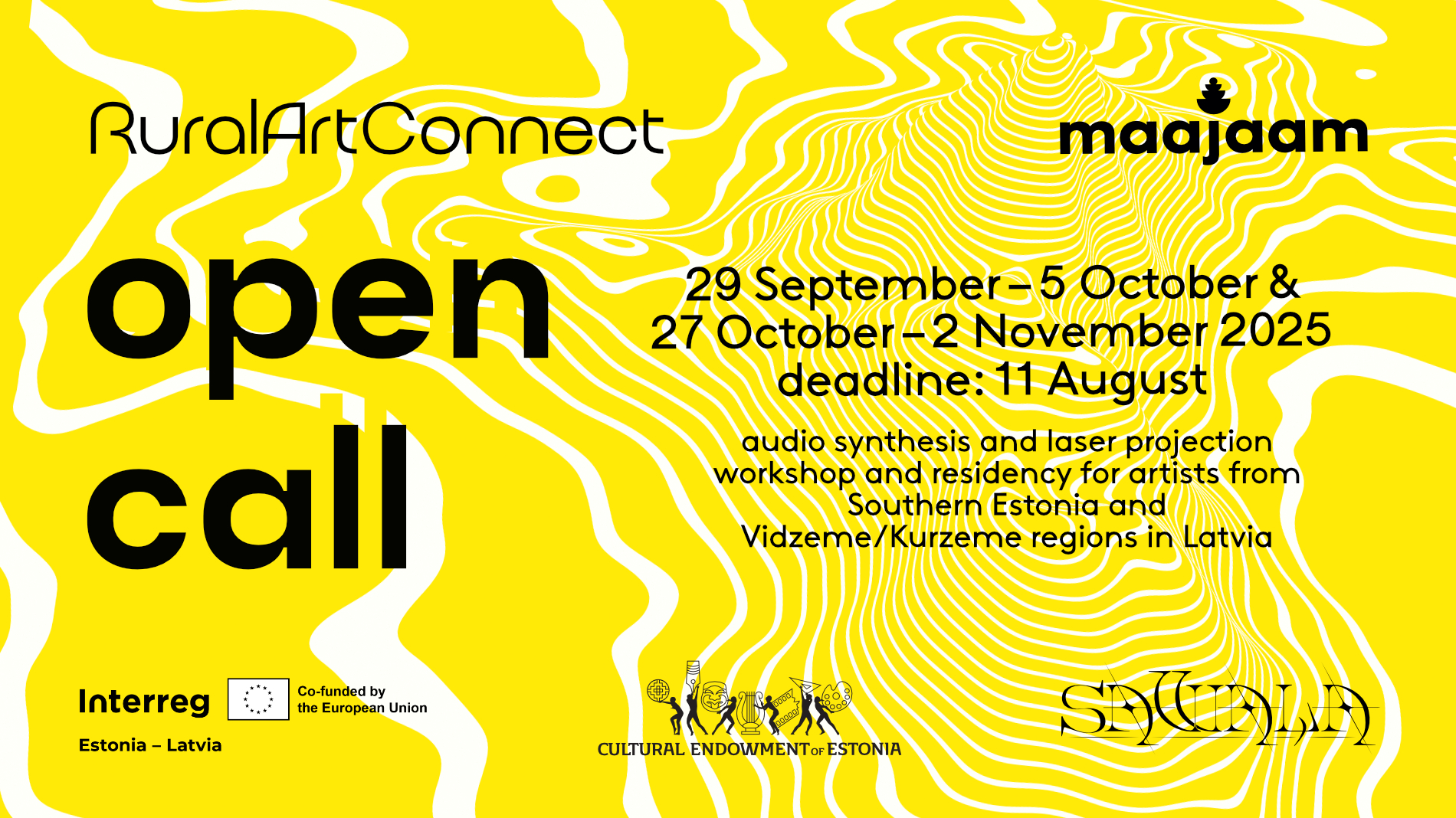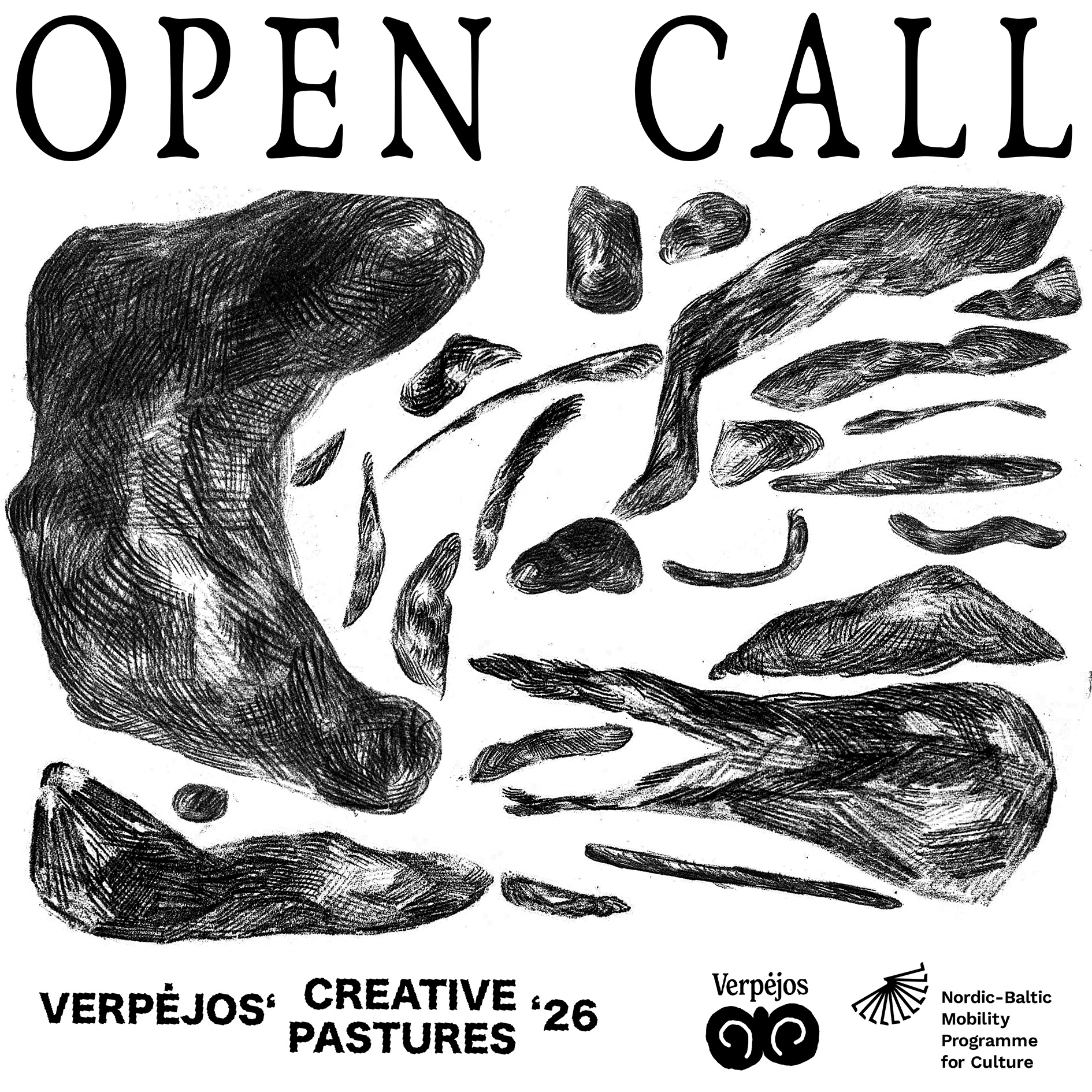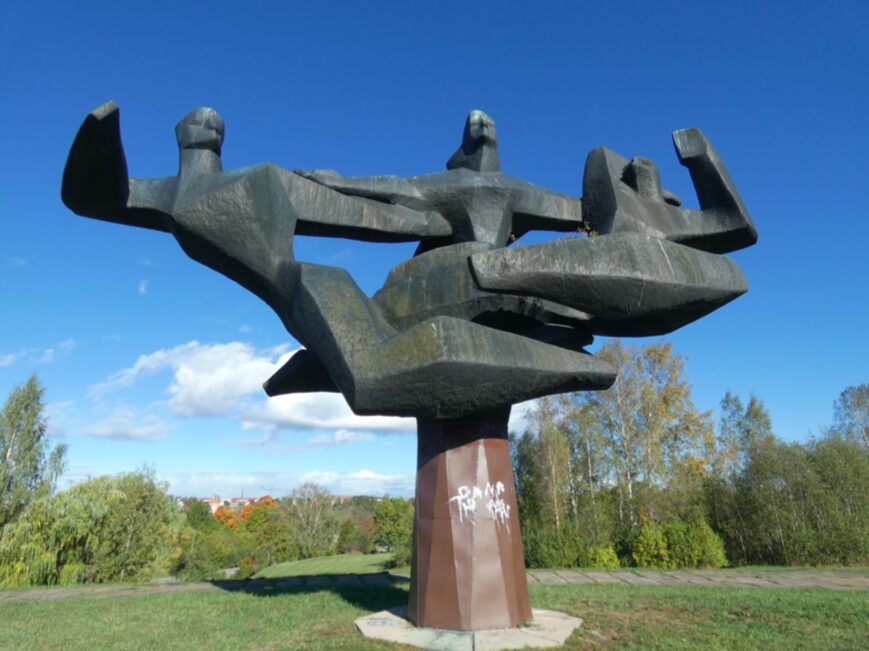Anna Mari Liivrand (1993) is a sculptor and installation artist who also works with drawings. She graduated from the Estonian Academy of Arts with a BA from the sculpture and installation department (2016) and a Masters in contemporary art (2022). She also studied fine arts at the Iceland University of the Arts. Liivrand is represented by Kogo Gallery, which is based in Tartu, Estonia. She uses poetic language to explore evanescence and melancholy in today’s contemporary society. In recent years, her focus has been on ornaments and decoration. She often examines these from the point of self-creation and how they act as anchor points in an ever-changing world filled with uncertainties and anxieties. Her works combine unusual materials and traditional craft practices, which come together in elegant spatial installations. Brigita Reinert, an art critic and the Head of the Contemporary Art Collection at the Art Museum of Estonia, talked with the artist about her creative work, basic principles, sources of inspiration, and latest exhibition projects.
Brigita Reinert: As an introductory question, I want to ask: What does your creative work process look like? What are the different stages that you go through when you are working?
Anna Mari Liivrand: My process tends to be a little all over the place as I work with several different mediums ranging from drawing to installation to craft. I often collect materials and objects and arrange them around my studio based on how their material qualities or shapes work together. I am trying to feel out what sorts of compositions and materials appeal to me purely on a sensuous level. But I also keep a large variety of visual materials that possess some unarticulated intrigue to me. I have postcards from museums with reproductions of artworks and a digital collection of photos of artworks, architecture, craft, technology, or other artefacts. For me, this collection, together with the physical materials, serves as a guidebook or ornamental book like the old masters used to keep and pass on. I usually browse this collection to remind myself of these interests in terms of themes, compositions, textures, and details.
Next to materiality and form lies drawing, which, to me, is like an organising principle that brings all the different topics together. Through drawing, I plan out installations, and after the installations have been physically executed, I once again start playing around with them in drawings. So, my process is something that flows from one state to another, taking on new shapes and ideas.

Anna Mari Liivrand, Evening Curves I and II, 2021. View from the exhibition Prick of a Daisy, ARS Project Space, 2021. Photo by Roman-Sten Tõnissoo
BR: An interest in unusual materials has been one of the common features of your work for a long time. Already during your studies as a young artist, you made works with wool, marzipan, shampoo, and other, so to say, strange materials. Later you have used your own teeth, burned skin, eyelashes, and similar elements in your installations. Can you explain in more detail why you are interested in unusual materials? What does working with such materials offer to you? Is there also a certain desire to redefine the so-called value hierarchies of different materials?
AML: All these materials I often tend to use also possess this ephemeral quality – like pieces of skin, eyelashes, or cat fur. Even shampoo is something that is meant to disappear after serving its function. I think it’s because I have been interested in the instability and disappearing that is characteristic of certain materials, and in addition, I aim to highlight humans’ need/desire to preserve things. I think humans have this constant desire to preserve everything – to preserve things, ideas, materials, and objects – and there is some absurdity to all of this. So, for me, it became interesting how to preserve materials that are meant to disappear or materials that we do not think are worth preserving – so to say, less valuable materials. I feel that working with materials that are fading or that could disappear soon can bring all the materials to the same level. For this reason, I have been collecting my own eyelashes for some time, and after a bad sunburn, I have collected pieces of my skin, which I have then integrated into my installations. I like to create these kinds of talismans – relics – out of these materials that normally should be discarded. In some cases, I have created a big structure around these little things that might disappear in the future.
When talking about controlling things around you, I am also interested in this practice people have of stabilising themselves through different objects, for example, amulets and talismans. Like you have this amulet that is supposed to provide protection from the outside world, which is also constantly changing. I think this psychological element of humans’ need to gain control over everything around us is very much in these pieces.
BR: Another theme that also comes up in your work is the theme of time. One can notice various temporal layers and an interest in different memories and time periods. This topic of time can also be viewed from a material- and object-centred perspective. What would you say about this? Can it be said that you are interested in materials (and objects) that have the ability to preserve history and different layers of time?
AML: Yes, I think, in a way, this topic of time is present in all my works. It is a play between past time and present time. I do refer to some materials that were maybe used in, for example, soviet era glassware. These objects are presented in my work as readymades. I am currently using them in the ‘Emotional Landscapes’ exhibition at Arka Gallery. The viewer clearly sees that these objects are from some other time and do not reflect this current moment that we are living in.
In my work, I also make some references to art history, for example, medieval art and baroque art. I feel that bringing together (visual) elements from different time periods interests me and creates this timeless environment for everything. I think these transient materials and images of different periods highlight how these grand stylistic movements, like baroque, have also somehow passed. When you bring them together in a similar situation, they become kind of equal.

View from the stand Whispers of Unfurling Tears, Liste Art Fair Basel, 2023. Photo by Studio Shapiro

Detail of the artwork Unfurling Tears (2023) by Anna Mari Liivrand. First presented at Liste Art Fair Basel, 2023. Photo by Albert Kerstna
BR: If, at the beginning, your work was more material- and object-based, then at some point, a certain shift occurred: you found a new visual language. How do you see this shift? When do you think it happened, and what was it about?
AML: At first, I was looking at the materials around me and was more interested in material properties. My practice was about collecting various materials, which, of course, I still do today. I have been especially interested in everyday materials, and so to say, feminine materials, including shampoo, bath salts, silk fabrics, pastel-coloured fabrics, and so on. Everything that you would associate more with feminine surroundings.
Where I previously considered myself more as a material-based artist, in recent years, I have drifted away from that a little. I would pick up glasses from drift shops and collect them in my studio. I would start thinking more about the shape, the figure, and the ornaments that were placed on top of these different objects. I became more interested in the decoration of these objects and was looking into how the decoration works in an artwork. What does it mean for artists and others? So, I started finding similarities in how decorative artists work and how I work. And I started to explore this world of decoration and what that world could mean in the context of my own practice.
BR: But could you specify why are you particularly interested in the historical and present context of ornamentation and decoration? Are you mostly interested in the aesthetic world of ornaments, or is there a more substantive reason for it?
AML: I think when you get into the world of ornaments and decoration, it starts telling you so much about the lines and space. It became interesting in the context of art history and the art world like how ornamentation and decoration are not things that are fully on the front lines. For example, nowadays, the concept of materiality is very much accepted, and it is very central to the work of many contemporary artists. I was contemplating why and what happened. Why did we stop engaging with these methods of artmaking? When I started reading and looking into the world of ornaments and decoration, what I found was that it was pushed aside in a way that was often laced with misogynistic ideas. It was considered a frivolous art form and maybe too excessive – even from an economic standpoint. There was an understanding that we don’t need it anymore, that it’s an outdated technique, and that it’s taking too many resources, for example.
What I started to find charming about these methods was how these ornamental symbols and decorations helped to make the world we live in more understandable and place different objects in certain times and periods. The ornament can also be seen as a method to claim something or make something yours.
Also, in a way, ornamentation and decoration are both rooted in lines and drawings. That is something very organic and relatable to me as well because many of my bigger installations emerge from these drawings that I create using different lines. What lines do is that they create a pathway for your gaze, inviting you in to look at things. Decoration invites a person to look at themself and to go along with the lines. And drawing does the same thing: directing your gaze in a certain way.
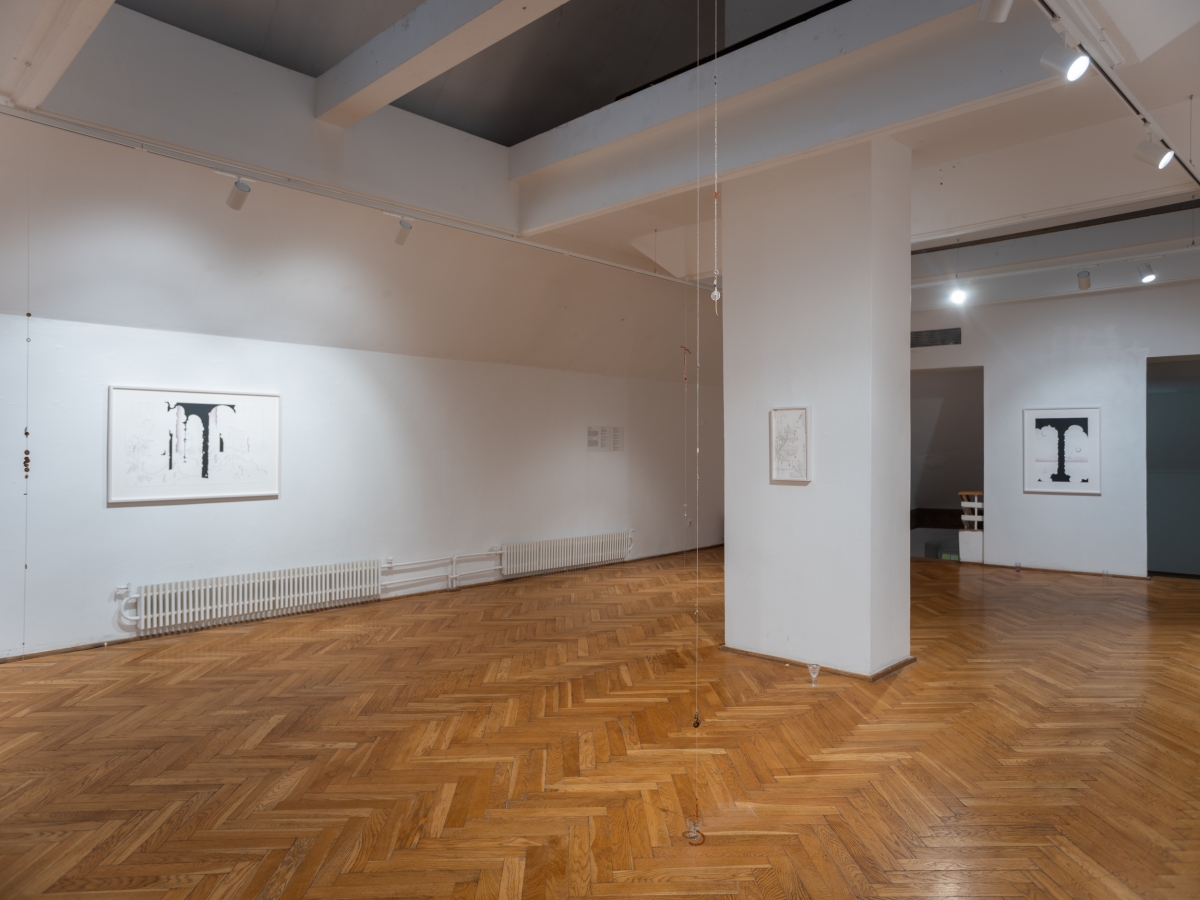
View from the exhibition Emotional Landscapes, Arka Gallery, 2023. Photo by Laurynas Skeisgiela
BR: Both ornamentation and craft practices have historically been associated with the phenomenon of femininity and are often seen as secondary practices in the field of fine arts. To what extent do you think about establishing the so-to-say female subjectivity or agency and your position as a female artist in the context of your work?
AML: I do not necessarily think about creating my artworks from a feminist perspective. But I do tend to gravitate more towards the world that the patriarchal, masculine world has rejected. In this way, I fully embrace things that are feminine, and I am not ashamed to say that my work is decorative, ornamental, or maybe even beautiful. (Laughs). All these visual elements, concepts, and themes running through the work are maybe more traditionally associated with feminine artworks or, for example, art that women create in their homes. I find so much strength in this world, but I don’t have to highlight it. I just think it is so great, and it just needs to be there.
BR: It seems to me that this topic is also somewhat related to the question of the concept of beauty and the search for beauty. It has been pointed out that, for you, the concept and meaning of beauty in art is important. Can you specify what beauty means to you in art and how important you consider it to be in your work?
AML: For me, beauty is immediately associated with aesthetics – to use the words of German philosopher Alexander Baumgarten – it is a science of sensitive knowing. It’s like a gut feeling. It can be knowing something about an artwork or some other thing that we don’t know how to articulate. There is this overwhelming quality to it. It is something that we must perceive with other faculties. It is very valuable to be able to perceive something with so much sensitivity that it creates a whole new experience. I really hope that my art also creates this experience where you perceive something without being able to articulate it.
BR: When it comes to your visual language, it has also been pointed out that it is gentle, poetic, and even fragile. How do you perceive it yourself? Is a certain tenderness, poeticism, and sensitivity characteristic of you as an artist? And have you done any experiments in this visual language or tried something unexpected as well?
AML: This is something that I have not necessarily thought about too much. It just started coming from somewhere, and I went with this gut feeling. Even when my work got a bit darker and visually sharper, it still had this fragile and delicate quality. Maybe it all does come down to this aspect of working with drawing and lines. I like to leave space for the viewer to wander around. There is a lot of empty space but, at the same time, a lot of details. I think this atmosphere of airiness and fragility characterises well the overall feeling that I hope the viewer experiences.
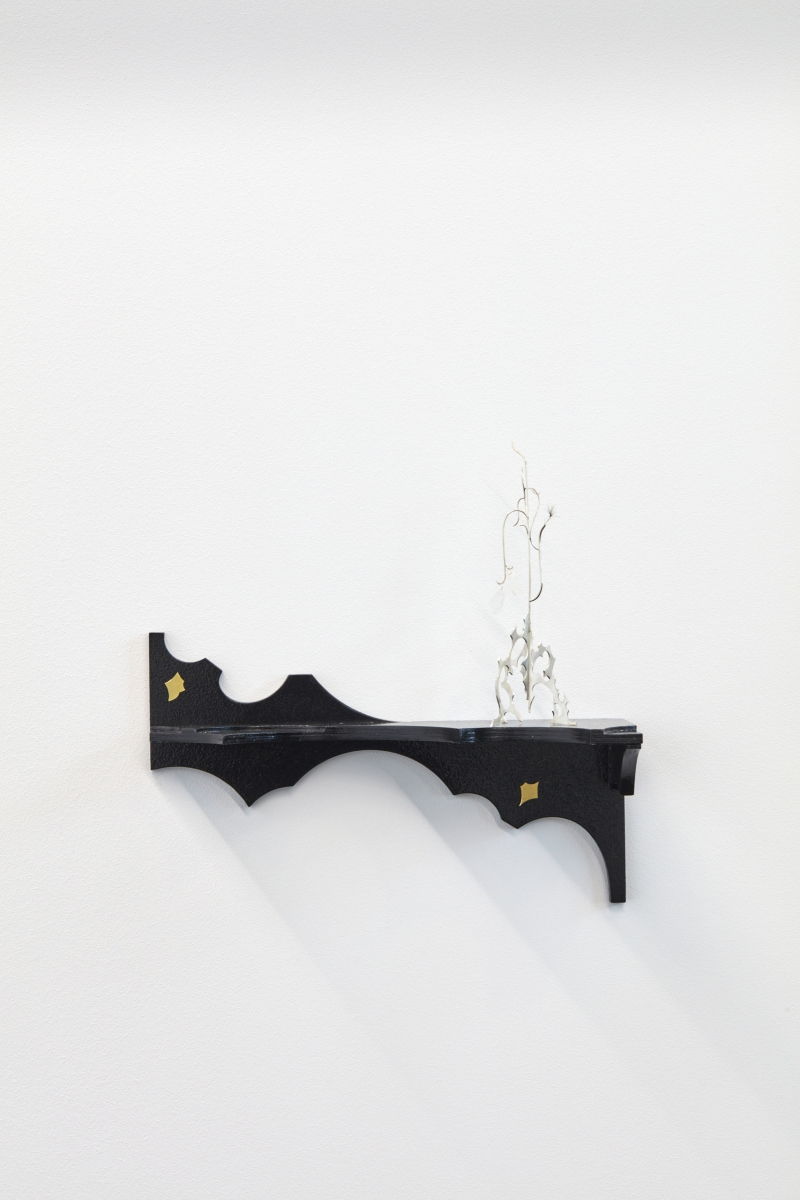
Anna Mari Liivrand, Lucky Charm I, 2023. Silver, eyelashes, sunburnt skin, 17 × 7 × 16,5 cm. View from Kogo Gallery’s stand at Liste Art Fair Basel. Photo by Studio Shapiro
BR: The notion of drawings has come up many times. It seems that in addition to other themes, a certain theme of the macrocosm and a grand mystical universe emerges from your drawings. One might notice even slight influences of Tõnis Vint’s school in these works – both regarding visual language (e.g. using ornaments) and the themes depicted. I wanted to ask what the role of drawings in your work is and what are the topics you study through them?
AML: I have thought about this connection to Tõnis Vint’s work as well, and in a way, stylistically, these works do have some similarities. But for Tõnis Vint, the ornament was a grand mystical thing that organises the universe. For me, the ornament is very personal and humane and a part of our everyday lives. Through sharing it, it passes on to new people and to new cultures, and it takes on its own life. Of course, humans also tend to attribute cosmic contexts and meanings to it, but I am more interested in its earthy side and qualities.
For me, the practice of drawing is a space where you can exercise your imagination fully. Creating physical installations and sculptures has its own limitations; you cannot do everything. But in drawing, you can imagine the space that is not there, and you can suspend things – like water droplets on a string in the air or rain as pearls falling from the sky. You can suspend time, or you can create impossible viewpoints and situations.
I also enjoy drawing landscapes. Landscapes are interesting settings where time and space kind of come together. On the paper, you can imagine the space that you plan to create physically without any limitations; you can play out these relationships between objects and sculptures, and you can play around with the space as well. You can make something flat, or you can give 3D qualities to something unexpected. You can animate certain things and make them seem realistic. It becomes a play of things that can exist and things that cannot exist. You can create more imaginative tension between things that would instantly fall apart in reality.
BR: How important is narrativity and storytelling in your work?
AML: Sometimes, I am super jealous of writers who write in many different genres. I fantasise about what I would do if I made an exhibition in the style of the murder, sci-fi or romance genres. In this way, narration is something that is very appealing to me. But I think how it works out in artworks is that it is not so much a linear form of narration but is composed of various layers of narratives. I lay different narratives on top of one another: something that is telling you about the past, something that is telling you about the present, something that is telling you about the human condition, and so on. And the emotional layers are also important. There is something that puts you on edge, something that lures you in, or something that offers you comfort.
BR: For me, references to occultism, mysticism, and magical thinking also appear in your work. For example, this glass ball motif, cod liver oil talismans as preservers of physical health, and magical objects related to the human body – wisdom teeth, eyelashes, and such. Or the references in the titles of the works: Talisman I and II, etc. Also relating to this is this idea of a person’s need to control their surroundings. What are your thoughts on this idea?
AML: I am interested in this ritualistic world that humans create around themselves and the shapes and images that emerge from it. For example, I am fascinated by these tiny little talismans that people keep in their pockets, these different stabilising mechanisms that humans use to find and anchor themselves in their surroundings. I investigate the ways we try to find some form of stability in an emotional or physical sense. Often, humans create collective rituals or personal rituals: these can be religious rituals or as mundane and daily as having a cup of coffee. These ritualistic qualities and how humans find comfort in these things are what interest me.
Something that I found interesting from the past is alchemy, mostly in the sense of transformation of materials, or how to transform materials from one thing into another – the magical aspects of it. For example, when you pour wine into a chalice in a church, it becomes something totally different. It is a moment when a material goes through transformation – its meaning changes. These are religious or magical rituals that change the meaning of certain materials and objects. It is this intriguing play with value that is interesting for me.
Related to this topic, I must add that one of the recurring motifs in my work is frogspawn – the initial stage of the frog’s lifecycle, where the frog is still inside the egg. In the alchemical works of Western Europe, the frog has been such an important symbol of transformation and transfiguration. A frog also undertakes various phases of shapeshifting before becoming a frog. And this symbol of change and transformation is quite important in the context of my works.
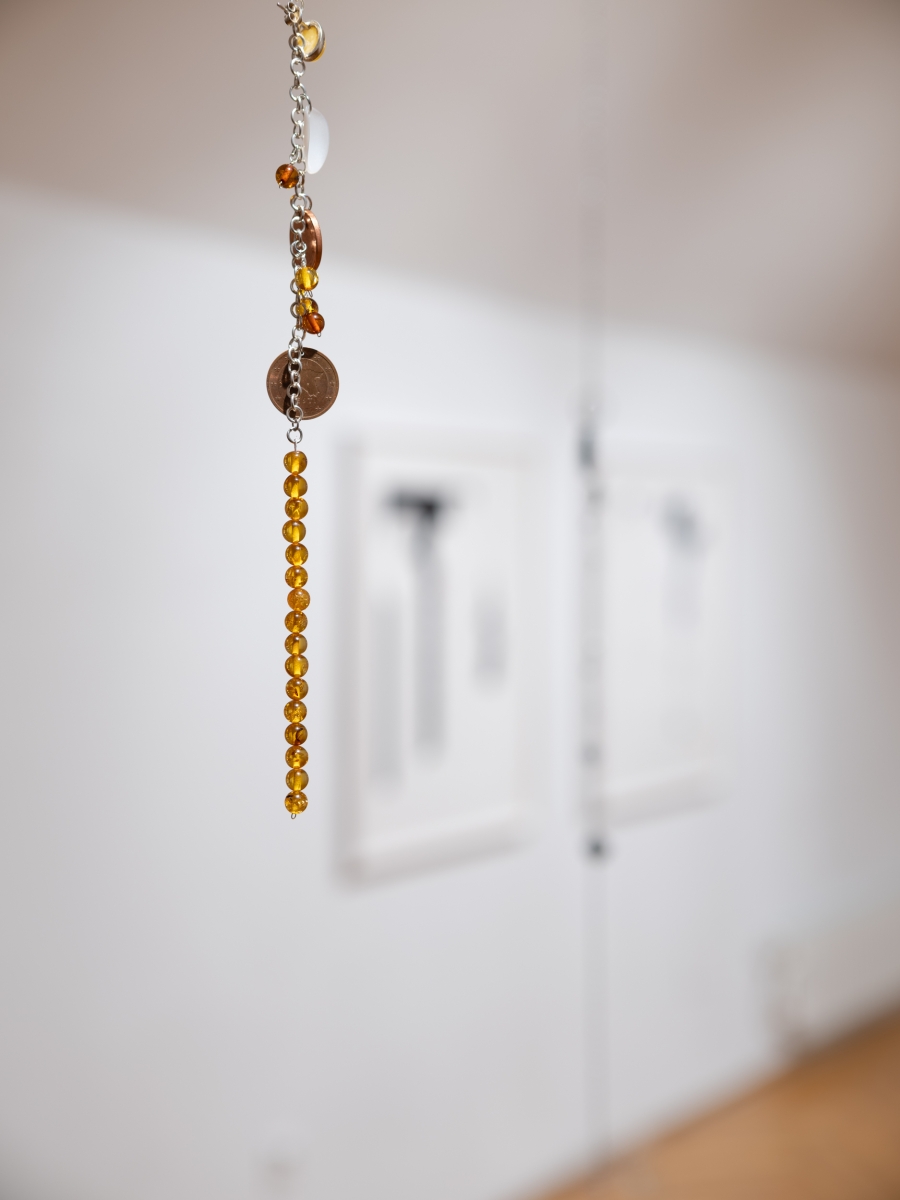
View from the exhibition Emotional Landscapes, Arka Gallery, 2023. Photo by Laurynas Skeisgiela
BR: The motifs found in your work are sometimes reminiscent of Gothic-style motifs – a black installation with thorns that reminds of cemetery gardens or details reminiscent of medieval architecture and interiors, for example – motifs that have this kind of sacred effect. How do you perceive this yourself? Could you highlight any of these elements in your work?
AML: When I was working on the exhibition ‘Prick of a Daisy’, from where these black silhouette sculptures originated, I was reading the life story of Estonian wood carver Christian Ackermann. I was looking at his work, especially this one altarpiece in black and gold, and I greatly enjoyed the drama of it – this emotional quality. It brings you in and wants to overpower you a little bit. I was interested in what it does emotionally. It was very alluring and seductive in a way; it wanted to captivate the viewer.
The way the sharpness and the sharp edges came to my work was more about the technique I often use while planning my installations with sketches. I work from a positive space and then start to take away bits and pieces, meaning I create a base form that is a geometrical shape or motif, and then start to manipulate it by cutting away pieces from the outline of the figure. For example, I draw a rectangle and start taking pieces from it, and then the new shape emerges. For me, this technique also relates to the notion of ruins: in a drawing, this shape of ruins is like a silhouette that is losing bits and pieces of itself.
But also, funeral rites and graveyards are something that I do reference a lot in my work. These are interesting sites for me. These are areas where people interact with their loved ones through different rituals – making their graves as nice as possible, leaving them different things and gifts, and creating personalised grave sites. Commemorative rituals and the way that a person is still somehow present after death are also interesting topics for me.

View from the exhibition Prick of a Daisy, ARS Project Space, 2021. Photo by Roman-Sten Tõnissoo

View from the exhibition Prick of a Daisy, ARS Project Space, 2021. Photo by Roman-Sten Tõnissoo
BR: These topics and motifs are recurring in your work: a garden that resembles a cemetery, the thorns covering the black installations, the poisonous plants, etc. All these elements were present at your stand, ‘Whispers of Unfurling Tears’, at Liste Art Fair Basel, where you participated with Kogo Gallery, and also later at the exhibition in Tütar Gallery this summer, ‘In the Shadow of Crumbling Silhouettes’. How do you see it: what was the mood or emotion that the viewer should have taken away from this exhibition?
And with what emotion should one generally look at your artworks? Is the tone rather pessimistic, or is it hopeful?
AML: I think it’s actually a sense of hope. I do not necessarily reject any negative feelings; I just find that these feelings that are considered more negative or unwanted are often very purifying for people. Sadness is purifying. And once you get through it, then comes the freshness, a new beginning. You feel hopeful again or rejuvenated.
The motif of thorns also appeared in the exhibition ‘Prick of a Daisy’, which was created during the pandemic, a tough time for me emotionally. I was thinking about how the world that was so familiar had turned into something super anxiety-inducing, and yet again, nothing had changed. It felt like thorns are lurking everywhere. The thorny vine was a symbol of the surrounding threat and the times we are living in.
BR: Previously, you have stated that you are interested in humanity’s attempts to preserve and control things and, on the other hand, that you are interested in the aesthetic world that people have created for themselves… How do you see the human’s role in your work?
AML: I think, for me, that is a very interesting question and a very difficult one because a lot of the things I refer to in my work are obviously related to humans. They are all about our material culture, how we perceive the world around us, and how we relate to other humans. But at the same time, there is a little bit of coldness or emptiness as well. Meaning that you feel you are more of a bystander than somebody who is organically part of this world that I have created in an exhibition space or in a drawing. It is the feeling that somehow the human isn’t present anymore. It is like a space that humans have left behind. And now it’s composed of the pieces – the remnants – that they have abandoned or forgotten.
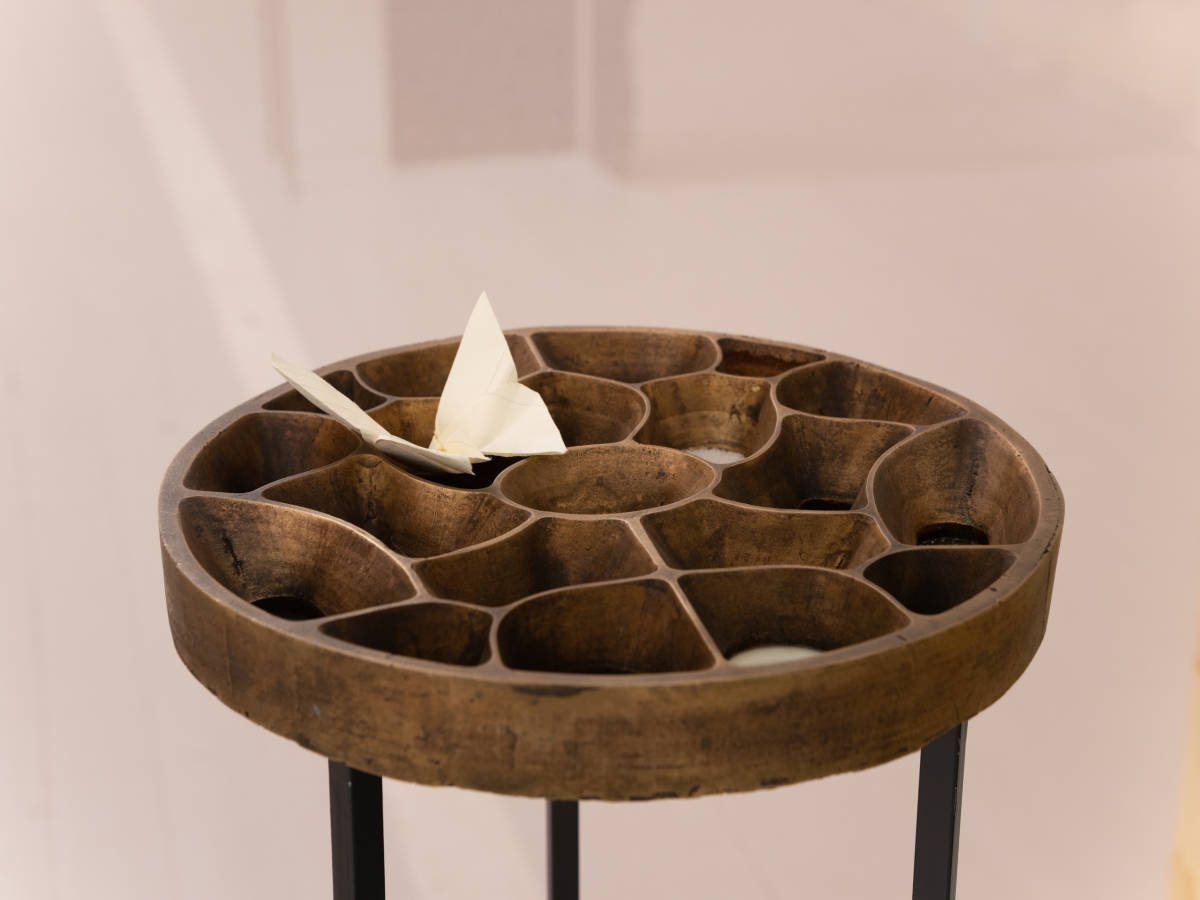
View from the exhibition Fragile Balance, Atletika Gallery, 2023. Photo by Laurynas Skeisgiela
BR: You are currently participating in two group exhibitions in Vilnius: ‘Fragile Balance’ in Atletika Gallery, and ‘Emotional Landscapes’ in Arka Gallery. Maybe you can say a little bit about the background of these exhibitions and talk about your works that are featured there.
AL: At the Arka Gallery exhibition, ‘Emotional Landscapes’, curated by Šelda Puķīte, I am showing drawings from the series ‘Crumbling Silhouettes’. These drawings are views into an imaginative paradise garden. When we think of medieval depictions of paradise, they often show different flowers blooming at the same time. In my drawings, instead of these paradise flowers, there are these toxic flowers from Estonian nature – e.g. you have lilies of the valley, cow parsnips, and other toxic plants. All of them possess this alluring nature; they entice you with their blooms or with their smell. You must know how to interact with them; otherwise, you could get badly hurt or poisoned. I was trying to convey this environment of current times: that underneath all this allure lurks a toxicity. A feeling that this paradise we are creating is not as pure as we think. These drawings are accompanied by little hanging sculptures, like charms, which I have put together from little pieces that you would maybe find at the bottom of your drawer. There are little fake nails, coins, pearls, chains – things that a person might leave behind them.
The exhibition ‘Fragile Balance’ is curated by Kaisa Maasik. She selected a combination of artworks from the ‘Prick of the Daisy’ exhibition and some pieces from my newer works. There is also a piece that has been created especially for this exhibition. There are many different themes that come to the fore. You see the sculptures that are almost black silhouettes or ruins. There is also a sculpture that is reminiscent of an altarpiece, a candy box cast in bronze. There, the visitor can leave, so to say, an offering in some form. Currently, there is some milk, coffee, and candies. It highlights the topics of rituals and esoteric thinking and taking a moment for yourself.
There are also hanging sculptures that form an installation that reminds of woods or bushes. Visually, the woods are, in a way, ornamental and refer to cemetery gardens and symbols. You can feel as if a person has passed through these woods and has forgotten things behind. You can also see references to the emotional states that the person may have left behind, too, in the form of tears, for example. For me, it is again the motive of purification and letting go.
BR: As a last question, I want to ask: What is your biggest secret dream as an artist?
AL: I have been dreaming about having an exhibition in Niguliste church. To give context to Lithuanian and Latvian readers, Niguliste is a museum in a church; it is not an active church. It is one of the branches of the Art Museum of Estonia, and it houses medieval art. I feel that the works that are, for example, in the permanent exhibition there – as well as others in the collection – are so directly connected with this world of life and death and questioning our place in it. I do reflect a lot about these motifs in my artworks, and I have brought in medieval ways of depicting things as well. Hence, I would be interested to see how my art would work in this context.

View from the exhibition Fragile Balance, Atletika Gallery, 2023. Photo by Laurynas Skeisgiela
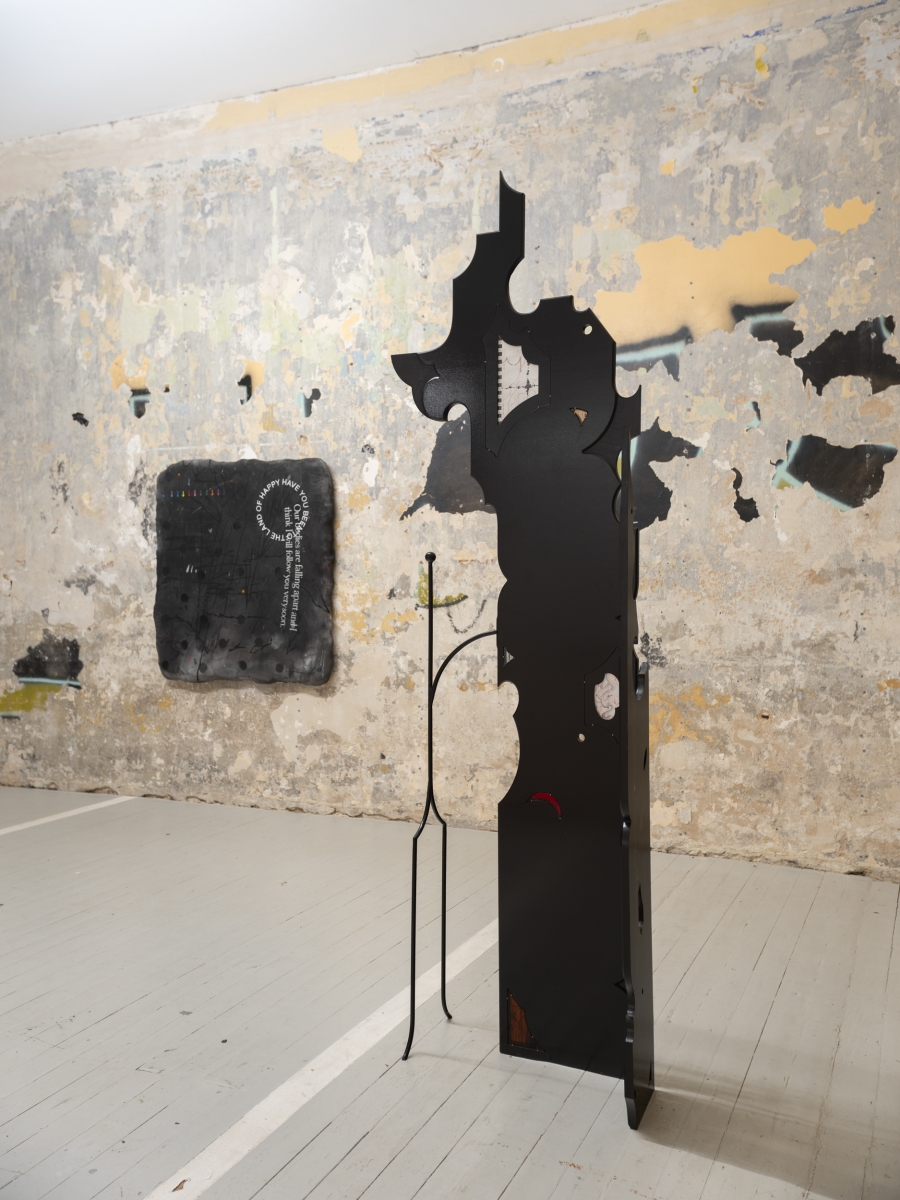
View from the exhibition Fragile Balance, Atletika Gallery, 2023. Photo by Laurynas Skeisgiela
